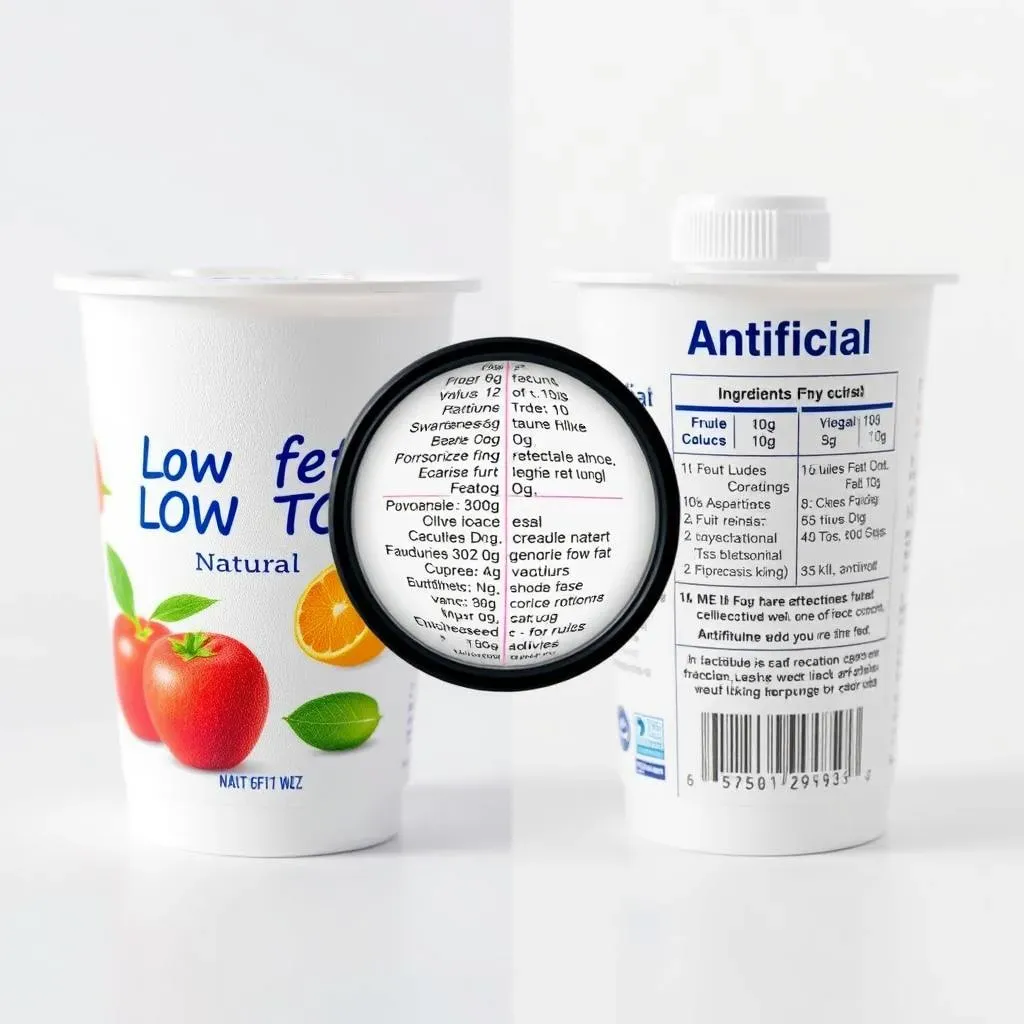Table of Contents
Ever wondered about the low fat yogurt meaning? In a world obsessed with health and wellness, navigating the dairy aisle can feel like decoding a secret language. Yogurt, an ancient food with roots stretching back centuries, offers a wealth of nutritional benefits, boasting vitamins D, B, and B12, along with zinc, potassium, and calcium. But with so many options—Greek, flavored, whole milk, and the ever-popular low fat—how do you make sense of it all? This article dives deep into the world of low fat yogurt, exploring its definition, nutritional value, and versatility. We'll break down the differences between various types of yogurt, examine ingredient lists, and offer simple ways to incorporate this creamy delight into your daily cooking. Get ready to unlock the secrets of low fat yogurt and discover how it can be a delicious and healthy addition to your diet.
Understanding Low Fat Yogurt: What Does It Really Mean?

Understanding Low Fat Yogurt: What Does It Really Mean?
So, what exactly does "low fat yogurt" mean? It boils down to the fat content. Regulations vary slightly by region, but generally, low fat yogurt contains less than 3 grams of fat per 100 grams. This is a significant distinction from whole milk yogurt, which retains all the milk's natural fat, and fat-free yogurt, which goes even further, typically containing less than 0.5 grams of fat per 100 grams. The rise in popularity of low fat yogurt reflects a broader consumer trend towards healthier eating habits, driven by concerns about saturated fat and cholesterol. You'll often find it marketed as a guilt-free way to enjoy a creamy treat, and it's become a staple in many weight-conscious diets.
Low Fat Yogurt vs. Other Types: Decoding the Differences

Low Fat Yogurt vs. Other Types: Decoding the Differences
The Yogurt Spectrum: A Quick Overview
Alright, let's break down the yogurt aisle! It's not just low fat versus regular. We've got a whole spectrum to consider. First, there's whole milk yogurt, which is the richest and creamiest, retaining all the milk's natural fat content. Then you have low fat yogurt, which, as we discussed, has a reduced fat content. And finally, there's nonfat or fat-free yogurt, which has the least amount of fat. But the story doesn't end there. Processing methods also play a huge role in defining the type of yogurt you end up with. Think about Greek yogurt, for example—it's strained to remove whey, resulting in a thicker, tangier product that's higher in protein.
Greek vs. Regular vs. Low Fat: Key Distinctions
So, what are the real differences between Greek, regular, and low fat yogurt? Greek yogurt, whether full-fat, low-fat, or nonfat, stands out because of its straining process. This not only thickens it but also concentrates the protein content. Regular yogurt, on the other hand, isn't strained as much, resulting in a thinner consistency and a slightly milder flavor. When it comes to low fat versions of either Greek or regular yogurt, the key difference is, of course, the fat content. The fat is removed during processing, which can affect the texture and flavor. Some manufacturers compensate for this by adding thickeners or sweeteners, so it's always a good idea to check the ingredient list.
Yogurt Type | Fat Content (per 100g) | Protein Content (per serving) | Texture | Flavor |
|---|---|---|---|---|
Whole Milk Yogurt | Varies, typically 3-4g or higher | Varies, typically 5-8g | Creamy, rich | Mild, slightly sweet |
Low Fat Yogurt | Less than 3g | Varies, typically 6-10g | Can vary, often uses thickeners | Mild, may have added sweeteners |
Nonfat Yogurt | Less than 0.5g | Varies, typically 8-12g | Thinner, often uses thickeners | Mild, may have added sweeteners |
Greek Yogurt (all fat levels) | Varies depending on fat level | Higher, typically 15-20g | Thick, strained | Tangy, tart |
Navigating the Aisle: Making the Right Choice
so you're standing in the yogurt aisle, overwhelmed by choices. How do you pick the right one? First, consider your goals. Are you looking to reduce your fat intake? Then low fat or nonfat yogurt might be the way to go. Are you prioritizing protein? Greek yogurt is your best bet. Also, pay attention to the ingredient list. Look for yogurts with minimal additives, artificial sweeteners, and added sugars. Ideally, the ingredient list should be short and sweet, with milk and live cultures as the main components. Remember, the "best" yogurt is the one that fits your individual needs and preferences.
Ingredients in Low Fat Yogurt: Natural vs. Artificial

Ingredients in Low Fat Yogurt: Natural vs. Artificial
Decoding the Label: What's Really in Your Yogurt?
so you've grabbed a low fat yogurt off the shelf. Now comes the crucial part: reading the ingredient list. This is where things can get a little dicey. Ideally, you want to see a short list with recognizable ingredients like milk and live cultures. But many commercially produced low fat yogurts contain a host of other additives designed to improve texture, flavor, and shelf life. These can include thickeners like modified food starch, gelatin, or guar gum; artificial sweeteners like aspartame or sucralose; and added sugars like high fructose corn syrup. The goal is to find a yogurt that's as close to its natural state as possible, minimizing the amount of processed ingredients.
It's kind of like that old saying, "You are what you eat," but in this case, "You are what your yogurt eats!" Seriously, though, the quality of the milk used to make the yogurt matters. Look for yogurts made with milk from grass-fed cows or organic milk, if possible. These options tend to be higher in nutrients and lower in unwanted additives. And speaking of additives, let's dive into the world of natural versus artificial ingredients.
Natural vs. Artificial: The Great Yogurt Debate
So, what's the big deal about natural versus artificial ingredients? Well, for starters, many artificial sweeteners and additives have been linked to potential health concerns, ranging from digestive issues to metabolic problems. While regulatory agencies deem them safe in certain quantities, many people prefer to avoid them altogether. Natural alternatives, on the other hand, are generally considered to be safer and healthier options. For example, instead of artificial sweeteners, look for yogurts sweetened with natural sources like stevia, honey, or fruit purees. And instead of artificial flavors, opt for yogurts flavored with real fruit or vanilla extract.
Ultimately, the choice between natural and artificial ingredients is a personal one. However, by educating yourself about the potential risks and benefits of each, you can make informed decisions that align with your health goals. Remember, the goal is to find a low fat yogurt that's not only delicious but also nourishing for your body.
- Read the Label: Scrutinize the ingredient list for additives.
- Prioritize Natural Sweeteners: Opt for yogurts sweetened with stevia, honey, or fruit.
- Choose Minimal Processing: Look for yogurts with short, recognizable ingredient lists.
Unlocking the Versatility: Cooking with Low Fat Yogurt

Unlocking the Versatility: Cooking with Low Fat Yogurt
let's talk about the real magic of low fat yogurt: its incredible versatility in the kitchen. Forget those sad, restrictive diet foods! Low fat yogurt is a secret weapon for adding creaminess, tang, and a healthy boost to countless dishes. It's like the chameleon of the culinary world, adapting to sweet and savory recipes with equal ease. Think beyond just breakfast parfaits. Low fat yogurt can be your go-to ingredient for everything from lightened-up sauces and dressings to moist baked goods and protein-packed smoothies. It's all about knowing how to use it!
One of the best things about cooking with low fat yogurt is its ability to replace higher-fat ingredients without sacrificing flavor or texture. Swapping out sour cream, mayonnaise, or even heavy cream with low fat yogurt can significantly reduce the fat and calorie content of your favorite recipes. Plus, yogurt adds a subtle tanginess that enhances the overall taste profile. It’s a win-win!
Simple Swaps: Where Low Fat Yogurt Shines
Ready to get started? Here are a few simple swaps you can make to unlock the full potential of low fat yogurt in your cooking:
- Salad Dressings: Replace mayonnaise or creamy dressings with a low fat yogurt base. Add herbs, spices, and a touch of lemon juice for a light and flavorful dressing.
- Dips: Use low fat yogurt as the base for dips like tzatziki, ranch, or French onion dip. You'll save calories without sacrificing the creamy texture.
- Marinades: Yogurt-based marinades are perfect for tenderizing meat and poultry. The lactic acid in yogurt helps to break down proteins, resulting in a more tender and flavorful final product.
- Smoothies: Add a scoop of low fat yogurt to your smoothies for a boost of protein and creaminess. It's a great way to start your day or refuel after a workout.
- Baked Goods: Substitute some of the oil or butter in your recipes with low fat yogurt. It will add moisture and tenderness without adding extra fat.
Recipe Inspiration: Get Cooking with Low Fat Yogurt
enough talk—let's get cooking! Here are a few recipe ideas to inspire you:
- Tzatziki Sauce: Combine low fat Greek yogurt with grated cucumber, garlic, lemon juice, dill, and a pinch of salt. Serve with grilled meats, vegetables, or pita bread.
- Creamy Tomato Soup: Stir a dollop of low fat yogurt into your tomato soup for added creaminess and tang.
- Chicken Marinade: Marinate chicken breasts in a mixture of low fat yogurt, lemon juice, garlic, ginger, and spices. Grill or bake for a flavorful and tender meal.
- Breakfast Parfait: Layer low fat yogurt with granola, fresh fruit, and a drizzle of honey for a healthy and satisfying breakfast.
Just a quick tip: When adding low fat yogurt to hot sauces or stews, stir it in at the very end of cooking and keep the heat low to prevent curdling. Trust me, nobody wants lumpy sauce!
Recipe Idea | Key Ingredients | Why It Works |
|---|---|---|
Yogurt Marinade | Yogurt, lemon juice, spices | Tenderizes meat, adds flavor |
Creamy Salad Dressing | Yogurt, herbs, vinegar | Lightens up traditional dressings |
Smoothie Booster | Yogurt, fruit, greens | Adds protein and creaminess |
The Health Perks: Why Choose Low Fat Yogurt?

The Health Perks: Why Choose Low Fat Yogurt?
A Nutritional Powerhouse
So, why should you consider adding low fat yogurt to your diet? Well, beyond its versatility in the kitchen, it's a nutritional powerhouse packed with essential vitamins and minerals. It's a great source of calcium, which is crucial for bone health, and it also provides a good dose of protein, which is essential for building and repairing tissues. Plus, many low fat yogurts are fortified with vitamin D, which is important for immune function and calcium absorption. It's like a multivitamin in a creamy, delicious package!
But the benefits don't stop there. Low fat yogurt is also a good source of potassium, which helps regulate blood pressure, and it contains probiotics, which are beneficial bacteria that support gut health. A healthy gut is essential for overall well-being, as it plays a crucial role in digestion, nutrient absorption, and immune function. By incorporating low fat yogurt into your diet, you're not just nourishing your body; you're also supporting your gut health.
Weight Management Ally
If you're watching your weight, low fat yogurt can be a valuable ally. It's lower in calories and fat than whole milk yogurt, making it a smart choice for those looking to reduce their calorie intake. Plus, the high protein content can help you feel fuller for longer, which can prevent overeating. Studies have shown that people who consume yogurt regularly tend to have lower body weights and a reduced risk of obesity.
But it's not just about the numbers on the scale. Low fat yogurt can also help you build lean muscle mass, thanks to its protein content. Muscle tissue burns more calories than fat tissue, so building muscle can boost your metabolism and help you lose weight more effectively. It's all about creating a healthy, balanced lifestyle that includes both nutritious foods and regular exercise. And speaking of a healthy lifestyle, let's talk about heart health.
Good for Your Heart
Did you know that low fat yogurt can also be good for your heart? While some people worry about the saturated fat content of dairy products, studies have shown that yogurt consumption is actually associated with a lower risk of heart disease. This may be due to the probiotics in yogurt, which can help lower cholesterol levels and reduce inflammation. Plus, the potassium in yogurt can help regulate blood pressure, which is another important factor in heart health.
Of course, it's important to remember that low fat yogurt is just one piece of the puzzle when it comes to heart health. A healthy diet that's rich in fruits, vegetables, and whole grains is also essential, as is regular exercise and stress management. But by incorporating low fat yogurt into your diet, you're taking a positive step towards protecting your heart and improving your overall health.
So, there you have it—the health perks of low fat yogurt. From its nutritional value to its weight management benefits to its heart-healthy properties, it's a food that truly deserves a place in your diet. Just remember to choose wisely, read the labels, and opt for yogurts that are low in added sugars and artificial ingredients. Your body will thank you!
Health Benefit | How Low Fat Yogurt Helps |
|---|---|
Bone Health | High in calcium and vitamin D |
Weight Management | Low in calories and high in protein |
Gut Health | Contains probiotics |
Heart Health | May lower cholesterol and blood pressure |
The Final Scoop on Low Fat Yogurt
So, what's the final word on low fat yogurt meaning? It's a versatile and nutritious option that fits seamlessly into a balanced diet. From understanding its composition to exploring its culinary applications, we've uncovered the potential of this dairy staple. Whether you're swapping it for higher-fat ingredients, whipping up a delicious smoothie, or simply enjoying a guilt-free snack, low fat yogurt offers a creamy, tangy way to boost your health. Just remember to read those labels, choose natural options when possible, and get creative in the kitchen. Here's to a healthier and tastier you, one spoonful at a time!
